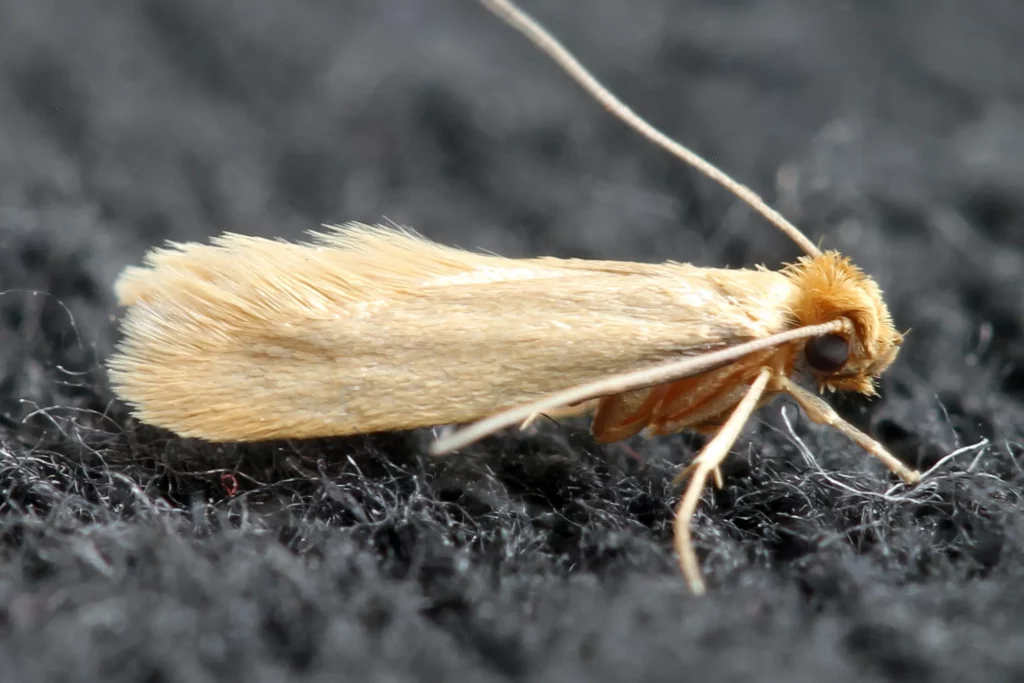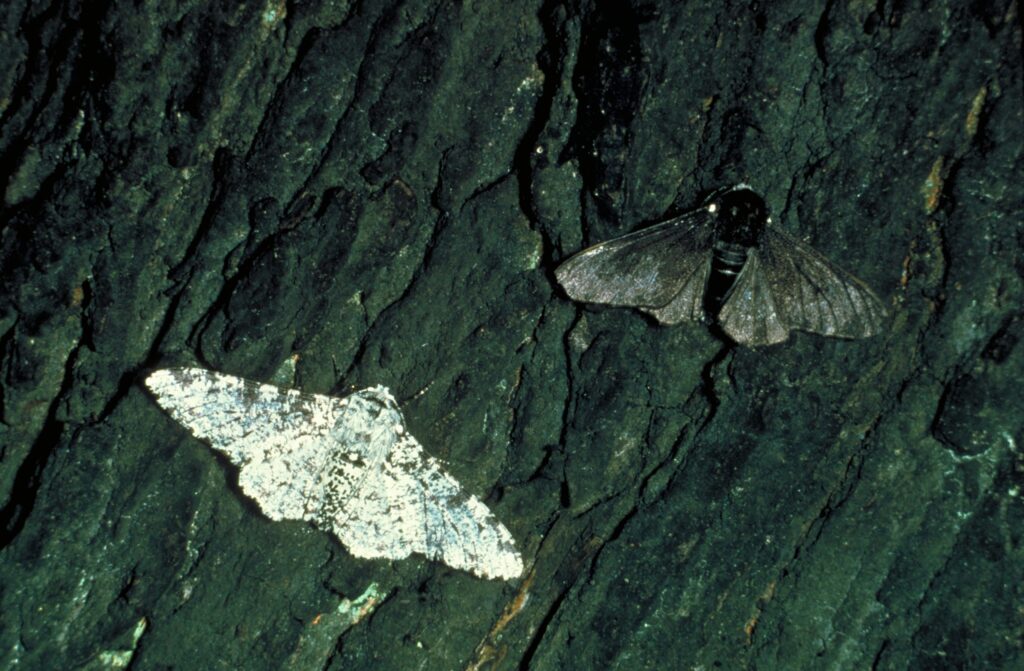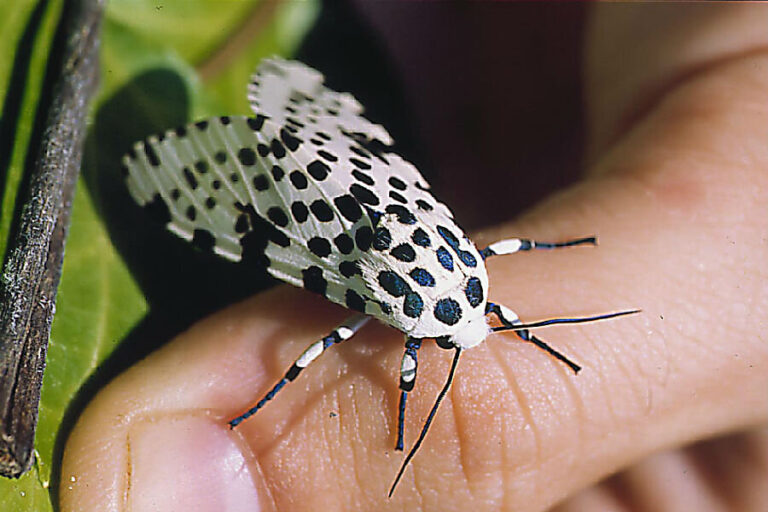The color of a typical moth can vary widely depending on the species. Moths come in a wide range of colors and patterns, and there is no one specific color that can be considered “typical” for all moths.
Some moths are brown or gray, which helps them blend into their surroundings for camouflage, while others can be brightly colored with intricate patterns.
Moths’ colors and patterns have evolved to serve various purposes, including camouflage, warning predators of toxicity, or attracting mates. So, there is a great diversity in the appearance of moths in the natural world.
How do moths use camouflage in their colors?
In the world of insects, moths have perfected the art of camouflage through their remarkable use of colors.
Brown and Gray Moths
Many moth species exhibit brown or gray coloration primarily for camouflage. This coloration allows them to blend in with their surroundings, making it difficult for predators to spot them.
Camouflage serves as a crucial survival strategy for moths, especially during their vulnerable stages of pupation and as caterpillars.
Examples of Brown and Gray Moth Species:
- Peppered Moth (Biston betularia): One of the most famous examples of industrial melanism, where the prevalence of dark-colored moths increased during the industrial revolution due to pollution and soot-covered trees, making them less visible to predators.
- Winter Moth (Operophtera brumata): These moths are predominantly gray and are well-camouflaged against tree bark during their rest periods.
- Silver Y Moth (Autographa gamma): Exhibits a grayish-brown coloration, providing excellent camouflage among various plant species.
Brightly Colored Moths

Brightly colored moths often serve different ecological roles compared to their more cryptic counterparts. These colors can convey various messages to predators and potential mates.
Warning Coloration:
Some brightly colored moths, particularly those with bold patterns or vivid hues like red, orange, or yellow, employ warning coloration to signal that they are toxic or unpalatable to predators.
The warning colors deter predators from attempting to eat them, as the predator associates these colors with a bad taste or toxicity. This phenomenon is known as aposematism.
Attracting Mates:
Bright colors in moths can also play a crucial role in attracting mates. Many moths are nocturnal and use pheromones and visual cues to locate potential mates.
Brightly colored moths may have distinctive wing patterns or bioluminescent structures that help them stand out in the dark and attract potential partners.
Examples of Brightly Colored Moth Species:
- Luna Moth (Actias luna): Known for its striking green coloration and long, delicate tails, which make it highly visible to potential mates in the moonlight.
- Rosy Maple Moth (Dryocampa rubicunda): These moths are brilliantly colored in shades of pink and yellow, serving as a visual signal for potential mates.
- Oleander Hawk-Moth (Daphnis nerii): With its vibrant pink and white coloration, this moth employs aposematism to deter predators.
What environmental factors influence moth coloration?
The intricate coloration of moths is a product of their evolutionary adaptation to environmental factors that shape their survival strategies.
Environmental Factors
Moths have evolved a wide range of colors and patterns to match the specific environments in which they live.
For example, moths that inhabit tree bark-covered habitats may have gray or brown coloration, allowing them to blend seamlessly with the bark. This camouflage reduces their visibility to predators such as birds.
Conversely, moths that dwell in floral environments may exhibit colors and patterns resembling the flowers they feed on, aiding in their disguise and helping them avoid detection by both predators and prey.
Seasonal Changes in Color:
Some moth species undergo seasonal color changes as an adaptation to the changing environment and availability of resources.
During the winter months, moths in cold climates might adopt a more muted coloration to match the snow-covered landscape, providing effective camouflage.
In contrast, during the warmer months, when vegetation is lush and colorful, some moths may become more vibrant to mimic flowers or leaves, aiding in their survival.
Evolutionary Adaptations
The coloration of moths is subject to natural selection, a fundamental mechanism of evolution. Moths with colorations that enhance their survival and reproduction are more likely to pass on their genes to the next generation.
In cases where a moth species is preyed upon by birds or other visually oriented predators, individuals with colorations that provide better camouflage or mimicry of their surroundings are more likely to survive and reproduce.
Over time, these advantageous colorations become more prevalent in the population, illustrating how natural selection shapes moth colors to align with their specific ecological niches.
Mimicry:
Mimicry is another powerful evolutionary adaptation seen in some moth species. Moths may evolve colorations that mimic the appearance of other organisms, objects, or patterns to deceive predators or gain other advantages.
Batesian mimicry is a phenomenon where harmless moths evolve to resemble toxic or unpalatable species, such as wasps or spiders. Predators avoid them, assuming they are dangerous.
Mullerian mimicry occurs when multiple harmful or unpalatable species evolve to resemble each other. This reinforces the avoidance behavior of predators, as they learn to associate a particular coloration or pattern with danger.
Some moths even mimic the appearance of bird droppings, tree bark, or leaves, making them inconspicuous to potential predators.
How do transparent moths achieve their translucency?
Transparency in moths, a fascinating phenomenon in the insect world, is achieved through a remarkable combination of structural and optical adaptations.
Transparent moths are a remarkable and unusual group within the Lepidoptera order. Unlike most moths, which are known for their various colors and patterns, transparent moths have evolved to be nearly or entirely translucent.
Transparency in moths is achieved through a combination of structural and physiological adaptations.
Structural Adaptations:
Some transparent moths have wings with specialized scales that lack pigments, allowing light to pass through the wing membranes. These transparent scales are often arranged in intricate patterns, giving the wings a delicate, lace-like appearance.
Moreover, transparent wings can serve as a form of camouflage, making the moths less visible to predators during the day or while resting on surfaces such as leaves or tree bark.
Physiological Adaptations:
The cuticle, or outer layer, of the transparent moth’s wings may have a high level of translucency due to a reduced presence of pigments or other materials that scatter light.
In addition, transparent moths often possess specialized proteins and structures in their wings that help minimize light absorption and maximize light transmission.
Examples of Transparent Moths:
The “Glasswing Butterfly” (Greta oto) is a well-known example of a transparent moth-like butterfly. Its wings are almost entirely transparent, making it appear as if it has no wings when in flight.
The “Sundew Moth” (Cryphia algae) is another transparent moth species that showcases the intricate patterns created by transparent wing scales.
Iridescent Moths:

Iridescence is a captivating optical phenomenon characterized by the changing colors of an object or surface as the viewing angle or illumination angle changes. Some moths have evolved to exhibit iridescent colors, which can serve various purposes:
Mechanism of Iridescence:
Iridescence in moths is often produced by the microstructure of their wing scales. These scales have ridges, grooves, or layers that interact with light in a way that causes interference and the creation of vibrant colors.
Potential Functions of Iridescence:
Iridescent colors can be used as signals to attract potential mates. Moths may use their shimmering wing patterns to communicate their quality or fitness to potential partners.
Iridescent colors can confuse or startle predators, making it difficult for them to pinpoint the location of the moth or anticipate its movements.
In some cases, iridescence can help moths blend into their surroundings by reflecting the colors of nearby objects, effectively providing camouflage.
Examples of Iridescent Moths:
The “Sunset Moth” (Urania ripheus) is famous for its stunning iridescent colors, including shades of blue, green, and red. It is primarily found in Madagascar and nearby regions.
Furthermore, the “Madagascan Moon Moth” (Argema mittrei) also exhibits iridescence on its large wings, which can shimmer with colors like blue and green when viewed from different angles.
FAQ’s :
What is the typical color of peppered moths?
The typical color of peppered moths is a mottled grayish-brown, providing camouflage against tree bark.
What colors are the typical and carbonaria versions of the moths?
The typical version of peppered moths is grayish-brown, while the carbonaria version is predominantly black.
What color is the typical version of the moths quizlet?
The typical version of peppered moths on Quizlet, as in nature, is grayish-brown.
What is the typical peppered moth?
The typical peppered moth is Biston betularia, known for its grayish-brown coloration and speckled appearance.
What is the peppered moth, and what are the variations in its color?
The peppered moth, Biston betularia, exhibits color variations, with the typical form being grayish-brown and the carbonaria form being predominantly black.
What determines the color of the moths?
Moth coloration is influenced by a combination of genetic factors, environmental adaptation for camouflage, and evolutionary pressures.
Are moths different colors?
Yes, moths come in a wide range of colors and patterns, with variations influenced by species, habitat, and adaptation strategies.
Final Words
Moths are a diverse and fascinating group of insects, each displaying a distinct palette of colors and patterns. Their coloration serves multifaceted purposes, from providing camouflage in specific habitats to warning predators of toxicity, and even attracting mates for reproduction. Environmental factors, including habitat and seasonal changes, play a significant role in shaping moth colors, ensuring their survival in ever-changing ecosystems.
Additionally, evolutionary adaptations, driven by natural selection and mimicry, have led to the development of striking and functional colorations in various moth species.
Furthermore, unique cases such as transparent moths, which employ structural and physiological adaptations for translucency, and iridescent moths, which exhibit shimmering colors for communication and deterrence

